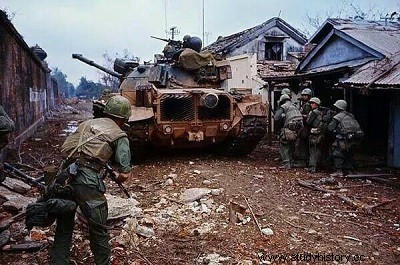
During the first fortnight of the offensive, the Communists suffered heavy losses:approximately 32,000 dead, plus 5,800 prisoners, or nearly half of the troops actively engaged. The ARVN lost only 2,800 men, the Americans a thousand. It was only at Huê that the attackers occupied their objectives for any appreciable time:this perhaps explains why the North Vietnamese could not bring in the reserves to exploit the successes. Although often outnumbered by holiday leave, the South Vietnamese militiamen and regulars who bore the brunt of the fight played their part with efficiency and courage. Nowhere did we see anything remotely resembling an uprising of the people against the government of Saigon. To American officials, all of this put together resulted in a severe defeat of the Communists.
But such was not the impression given by the miles of print and television footage produced by American reporters . As one of them, Peter Braestrup, then correspondent for the Washington Post, was to note nine years later in a highly documented study:reality”.
Apart from the pressure of time which. almost inevitably, tends to cause journalistic errors, there was another cause for this misunderstanding. Having forgotten, or disregarded, the few official warnings about the likely enemy preparations for a large-scale operation, reporters instead recalled the President's optimistic statements during the fall campaign. Didn't Westmoreland anticipate that American withdrawals would begin in 1969? It seemed sheer madness to journalists, who saw South Vietnam as the scene of carnage, crushed by the blows of the enemy - although, as it turned out, the withdrawals actually began in 1969. Very few journalists and television commentators had combat experience or had studied military history. For them, the Tet offensive represented an incredible shock, a resounding disaster, an obvious American and South Vietnamese defeat! None of them thought of drawing a parallel with other wars, in which the loser mounted a superb surprise attack, such as Germany in 1918 and at the end of 1944. Definitely skeptical, they were determined to expose the subterfuges and the chicanery they saw behind the Johnson administration's rosy pronouncements. It was not a conspiracy, it was a simple group reaction based on shared prejudices and misunderstandings. But the result was almost the same...
The damage done in the cities, light compared to that of the first and second world wars, seemed appalling to most of the journalists! Television cameras, trained on a badly damaged block, managed to make the entire town look like ruins. A journalist reported the remarks made by an anonymous major of the US Army in the city of Ben Tre, a quarter of which had suffered heavily:“It became necessary to destroy the city in order to be able to save it”. It turned into a leitmotif - and those responsible for such devastation were never the Communists, who had carried the war into the interior of the cities, but the Americans and the South Vietnamese, with their artillery and their aviation. Civilians killed (some 7,000) and refugees (nearly 700,000), sad victims of the fighting, had the honor of the headlines, but not the 5,000 or more civilians systematically tortured and executed by the Communists in Hué and elsewhere. ... As for the genuine sympathy for the plight of homeless civilians, lacking food, it came from the government of the Republic of China (Taiwan), which immediately sent material aid in addition to its military assistance (a maximum of 31 advisers ), and the governments of two other countries not engaged in this war, Canada and Norway.
Reporters claimed that the imperial palace of Huê was totally destroyed:in fact, the damage was superficial . Saigon, which had suffered only slightly, was presented on television as a smoking ruin. And outrage erupted around the world when the publication of the photographs taken by Eddie Adams of the Associated Press showing a Vietcong prisoner, in civilian clothes, being executed with a revolver, at close range, by Brigadier General Nguyen Ngoc Loan, Chief of Saigon Police Force.
